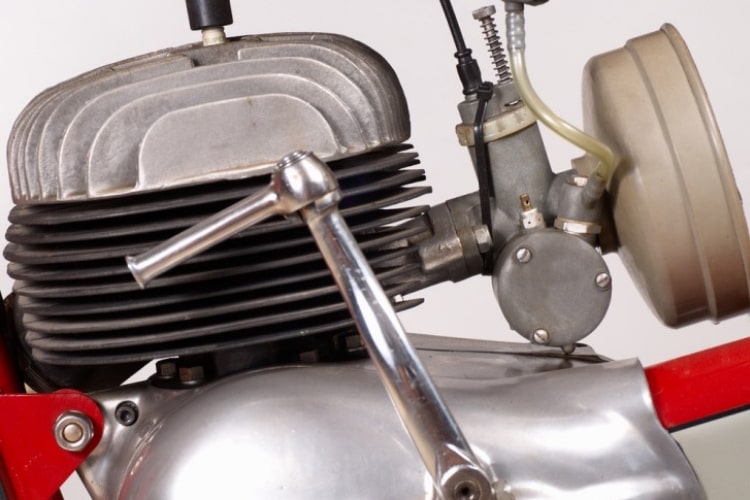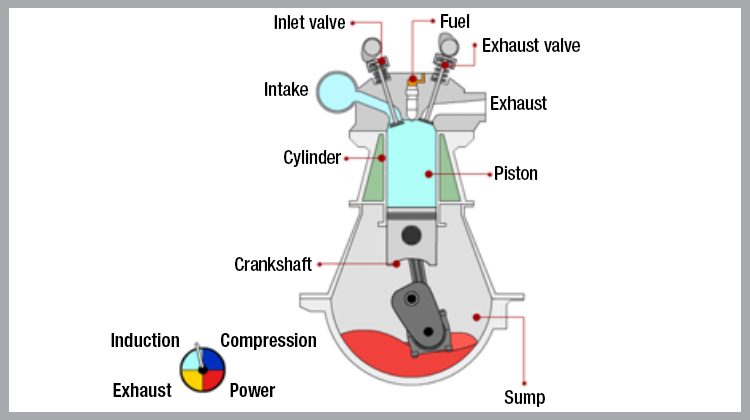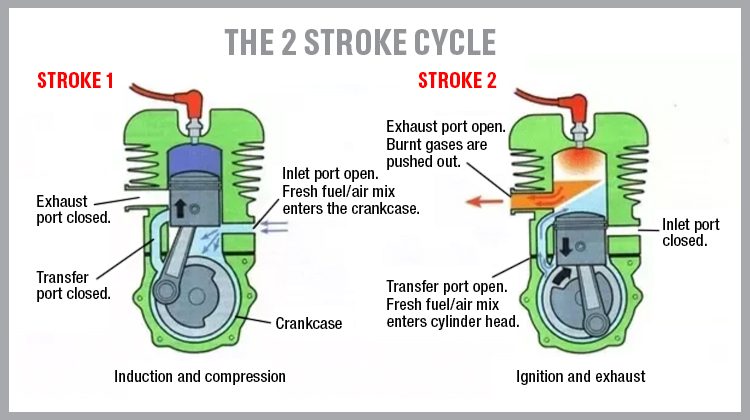Difference Between 2 Stroke and 4 Stroke. Although automobile engines have evolved over time, two basic gasoline-powered combustion engine types have remained: the 2-stroke and 4-stroke. While we’re sure you’ve heard of these phrases before, do you truly understa d what they mean? What’s the difference between them, and which is the superior option? To find out the solutions, keep reading.
What is the Difference Between 2 Stroke and 4 Stroke?
There have been two major combustion types that are fueled by gasoline throughout the history of the automobile and engine design — the 2-cycle (or 2-stroke) and the 4-cycle (or 4-stroke).
While you may be familiar with these phrases, you may be asking what the difference is. If you’re looking for a new engine, here’s what you should know about efficiency and maintenance.
Modern formulas of engine oils may be utilized in both 4-cycle and 2-cycle engines as a technical leader in lubricants. But how do two-cycle and four-cycle engines differ? The numbers 2 and 4 represent the number of piston strokes required by the engine to complete the entire fuel combustion and exhaust process.
To achieve fuel intake or induction, compression, fuel ignition (combustion), and exhaust in a four-cycle engine, the piston travels up and down the engine cylinder four times.

This is accomplished in two piston strokes in a two-cycle engine (one up and one down the piston cylinder). The terms 2 cycle and 2 stroke are frequently interchanged in the industry and on the market.
Definition of Stroke in Engines
2-stroke engines are used in most small, hand-held lawn and garden tools like string trimmers and chainsaws, whereas 4-stroke engines are used in bigger machinery like lawn and garden tractors. Both types of engines are available in lawnmowers.
Dr. Dick Parish of the LSU AgCenter outlines the differences and why 2-stroke engines are more popular on small equipment.
“Most people refer to the two engine types as ‘2-cycle’ or ‘4-cycle,'” Parish explains. “While this phrase is often used, it is inaccurate.”
Every reciprocating internal combustion engine, according to the engineer, goes through a “cycle” of five functions: intake, compression, ignition, combustion, and exhaust. In a 2-stroke engine, all five functions of the cycle are completed in only two piston strokes (or one revolution of the crankshaft). The five operations of a four-stroke engine need four piston strokes (or two revolutions of the crankshaft).
Parish claims that 2-stroke engines are lubricated by oil mixed with the fuel rather than a reservoir in the crankcase. Much of this oil is not burnt by the engine and is instead ejected along with the exhaust stream, resulting in increased emissions and smoke.
He further claims that because 2-stroke engines have a better power-to-weight ratio than most 4-stroke engines, they function well in hand-carried applications like blowers and string trimmers.
“Typically, 2-stroke engines rev higher than 4-stroke engines, which accounts for most of the increased power per pound,” Parish explains. “In addition, instead of valves, small 2-stroke engines use intake and exhaust ports, which saves weight and money.”
Because of the oil in the gasoline, Parish says that spark plug fouling is more common on 2-stroke engines, necessitating more regular spark plug replacements.
According to the engineer, oil in the crankcase lubricates 4-stroke engines, so the oil does not combine with gasoline.
“A tab on the bottom of the piston rod sprays oil up into the cylinder on small engines like lawnmowers,” he explains. “An oil pump distributes the oil under pressure and via an oil filter on bigger engines, such as those used in garden tractors.”
Various engine manufacturers suggest different oil mix ratios for their engines, according to Parish.
“If you have many 2-stroke engines that aren’t all the same brand,” he adds, “you may need to store distinct fuel-to-oil mixtures for each machine.” The typical ratios are 32 to 1 (gasoline to oil) to 50 to 1 (gasoline to oil).

Parish explains that “you may buy compact containers of oil that are metered to deliver the correct amount of oil for a gallon of gasoline for a certain suggested mix ratio.” “However, purchasing oil in greater amounts may be more cost-effective.”
Parish also warns that unless you return to the vendor, you may have difficulty locating a tiny container that is measured for the ratio you want. Only one or two ratios are available in most hardware stores, garden centers, bargain stores, and other comparable establishments.
“Don’t think that the tiny container of 2-cycle oil you get at the bargain shop will give you the proper ratio for your engine,” Parish cautions. “Check the label for the ratio. If you don’t have the right measured container, knowing how much oil you need for your necessary ratio is important.”
Parish suggests beginning with a clean, empty jar and adding the appropriate amount of oil. After that, pour 1 gallon of gasoline into the container, shut it, and shake it to combine the fuels. Each time you use the gasoline mix, agitate the container before pouring.
“If employed in the right application, any sort of engine may do a terrific job,” Parish adds. “If you have a 2-stroke engine, make sure the oil and gas are mixed properly.”
How Do Combustion Engines Work, and What Is A “Stroke” Anyways?
To grasp the differences between these two engines, you must first learn the fundamentals.
The piston travels up and down within the cylinder throughout the combustion cycle of an engine. The phrases “top dead center” (TDC) and “bottom dead center” (BDC) are used to describe the location of the piston within the cylinder.
TDC refers to the position closest to the valves, whereas BDC refers to the position farthest away. When the piston travels from TDC to BDC or vice versa, it is called a stroke. The whole process of gas and air being drawn into the piston, igniting it, and releasing the exhaust is known as a combustion revolution or combustion cycle:
Intake
As the piston descends the cylinder, a combination of fuel and air is let into the combustion chamber.
Compression
The piston returns to its original position in the cylinder, and the intake valve is closed to compress the gasses inside.
Combustion
The gas is ignited by a spark from the spark plug.
Exhaust
The piston returns to its original position in the cylinder, and the exhaust valve is opened.
Difference Between 2 Stroke and 4 Stroke
The difference between a 2-stroke and 4-stroke engine is the number of times the piston travels up and down during each cycle, which determines how rapidly the combustion cycle happens.
4 Stroke Working Principle
The piston of a 4-stroke engine completes two strokes throughout each revolution: one compression stroke and one exhaust stroke, each followed by a return stroke. The spark plugs only ignite once every other revolution, and power is generated per four piston strokes. These engines also do not require pre-mixing of gasoline and oil since the oil is contained in a separate compartment.

A four-cycle engine uses four separate piston strokes or cycles to function. The four phases of a four-cycle engine are listed below:
- The piston travels down the cylinder during a stroke. Fuel and air are sucked into the engine to be burned. To let gasoline into the cylinder, the intake valve(s) open and the exhaust valve(s) close.
- When both the intake and exhaust valves are closed, the piston travels up the cylinder and compresses the fuel/air combination.
- Perfect timing ignites the fuel/air combination, pushing the piston down the cylinder and creating engine power to run the vehicle.
- The combustion exhaust is removed by closing the intake valve(s) and opening the exhaust valve(s).
- The 4 cycles repeat.
2 Stroke Working Principle
The whole combustion cycle in a 2-stroke engine is accomplished with just one piston stroke: compression followed by the explosion of compressed fuel. The exhaust is let out during the return stroke, and a fresh fuel mixture enters the cylinder. The spark plugs ignite once each revolution, and power is generated once per two piston strokes. Oil must also be pre-mixed with the gasoline in two-stroke engines.

A two-cycle engine goes through the same induction, compression, power, and exhaust processes as a four-stroke engine, but with the piston going through two strokes (up and then down).
In this case, induction and compression happen in one piston stroke, but ignition (power) and exhaust happen in the next. In addition, at the ignition stage, the fuel is mixed with the oil and burned jointly.
Comparing 2-Stroke and 4-Stroke Engines
When it comes to the fundamental distinctions between 2- and 4-stroke engines, the most significant distinction is in how they work. To comprehend how an engine operates, you must first comprehend the notion of combustion in a compact engine.
In this circumstance, combustion, which is simply the process of burning something, is required for an engine to create energy. In terms of combustion, both a 2-stroke and 4-stroke engine complete a cycle, however, the piston is different. More specifically, the piston’s necessary number of strokes.
For example, it takes two piston strokes for a 2-stroke engine to complete the whole combustion cycle, which consists of five functions (intake, compression, ignition, combustion, and exhaust). In comparison, the cycle of a 4-stroke engine is finished after four piston strokes — or one crankshaft rotation vs. two crankshaft revolutions.
Cars, buses, and lorries are more likely to have a 4-stroke engine, whereas scooters and mopeds are more likely to have a 2-stroke engine. However, certain small engine tools and trimmers are now available with 2-stroke or 4-stroke engines; is there a significant difference in terms of performance and general maintenance in this case? Visit here to answer your question.
Which Is Better, A 2-Stroke Engine or 4-Stroke Engine for Smaller Tools and Machines?
When comparing these two types of engines, each has advantages and disadvantages.
For starters, 2-stroke engines are significantly lighter and less expensive to produce. They are also less difficult to fix than 4-stroke engines. However, unless you actively maintain the engine, repairs will be required more regularly.
In that sense, if you want to keep expenses down while still getting the most out of an efficient machine or equipment, you must be proactive in maintaining its parts. If you choose a 2-stroke engine, keep in mind that they are easier to repair due to their design, but they will not survive as long as a 4-stroke engine if regular maintenance is not prioritized. Understand your engine and take preventative measures to avoid problems.
Pros and Cons
So, which is the better option? Here are some of the advantages and disadvantages of both engine designs:
- In terms of efficiency, the 4-stroke is unquestionably superior. This is because gasoline is utilized just once per four strokes.
- Four-stroke engines are significantly heavier than two-stroke engines, weighing up to 50% more.
- A 2-stroke engine typically produces greater torque at higher RPMs, but a 4-stroke engine produces more torque at lower RPMs.
- A 4-stroke engine is also much quieter, whereas a 2-stroke engine is much louder and produces a noticeable, high-pitched “buzzing” sound.
- Because 2-stroke engines are built to run at a higher RPM, they wear out more quickly; 4-stroke engines are more robust. 2-stroke engines, on the other hand, are more powerful.
- Because two-stroke engines have a simpler design, they are easier to repair. They don’t have valves; instead, they have ports. Because four-stroke engines have more components, they are more expensive, and repairs are more expensive.
- Pre-mixing of oil and gasoline is required for two-stroke engines, but not for four-stroke engines.
- Four-stroke engines are more ecologically friendly; with a two-stroke engine, burned oil is discharged into the atmosphere along with the exhaust.
Conclusion
Remote-control vehicles, chainsaws, lawnmowers, boat motors, and dirt motorcycles are all examples of two-stroke engines in smaller applications. Four-stroke engines may be found in anything from go-karts to lawnmowers and dirt motorcycles to your car’s internal combustion engine. It’s up to you to choose whatever engine and for what purpose you want to use it.



